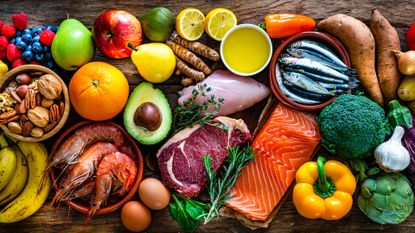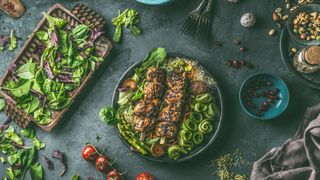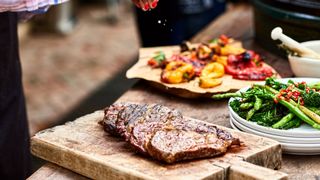What is the paleo diet?
What is the paleo diet? We asked a dietitian about the pros and cons of this eating plan


If you’ve been wondering; what is the paleo diet? You’re not alone. The paleo diet was created to emulate the eating patterns of our Stone Age ancestors before the arrival of structured agriculture. Followers of the paleo diet claim that our genetic makeup is not matched for a diet that includes foods from modern farming, such as grains or dairy.
A paleo diet typically includes lean meats, fish, fruits, vegetables, nuts, and seeds - foods that in the past could be obtained by hunting and gathering. There are several positive attributes to the diet, like increasing vegetable intake and eating fewer processed foods. The paleo diet may offer some health benefits combined with activity on the best exercise machines to lose weight.
With so many different types of diets available, it’s well worth knowing exactly what each of them involves before committing to trying them out.
What is the paleo diet, and how does it work?
The paleo diet attempts to replicate the eating habits of our ancestors from the paleolithic or Stone Age era. Humans needed to act as hunter-gatherers during this period to meet their nutritional needs.
The gastroenterologist Dr Walter L Voegtlin, in his 1975 book, The Stone Age Diet, first promoted paleolithic living as a diet concept. Since then, hundreds of books about paleo eating have been published, all with varying rules and restrictions. Common names for this diet include the caveman diet, the hunter-gatherer diet, and the Stone Age diet.
To replicate ancient eating, paleo followers recommend consuming lots of meat, fish, vegetables, and nuts, along with some fruit with a low glycaemic index (slow release foods). Unfortunately, the paleo diet doesn’t include grains, dairy, or legumes. In addition, added sugars (except for small amounts of maple syrup and honey), artificial sweeteners, and most processed foods are also banned.
Registered dietician Beth Kennedy explains the idea behind paleo, “This diet hinges on reverting to what our prehistoric ancestors ate and rejects modern-day, processed foods to improve healthcare outcomes. People can lose weight with paleo, but I don’t recommend cutting out whole food groups to my patients, especially healthy grains, legumes, and dairy.”
Get the Fit&Well Newsletter
Start your week with achievable workout ideas, health tips and wellbeing advice in your inbox.

Kennedy continues, “There is debate about several aspects of the paleo diet: what foods existed at the time, the variation in diets depending on region, and disagreement among paleo enthusiasts on what is included/excluded from the diet. Because of these differences, there is no one ‘true’ paleo diet.”
Overall, the paleo diet is high in protein, moderate in fat (mainly unsaturated fats), low in carbohydrates and low in sodium and refined sugars. The fats included in paleo are mostly ‘good’ monounsaturated and polyunsaturated fats that come from oily fish, avocado, olive oil, and nuts and seeds.
Does a paleo diet work long-term?
The paleo diet can lead to weight loss if there is an overall calorie deficit, similar to any other type of diet. Indeed, research published in 2019 has shown that implementing a paleo diet may reduce body weight, waist circumference, and BMI.
However, the paleo diet can be somewhat restrictive. Some experts do not support the strict elimination of foods like grains or dairy, except for medical issues like food intolerances or allergies. Cutting out grains and dairy from your diet may lead to nutrient deficiencies.
Like any other diet that eliminates major food categories, the paleo diet can be difficult to sustain long-term. Instead, you can always consider following a modified version of this diet, where you embrace the healthy principles - like eating more produce and limiting added sugar - and allow yourself some grace to sometimes stray from stringent eliminations. The best diet is feasible to stick to for life and helps you feel great.
Many studies carried out on the paleo diet had small sample sizes and only studied short-term effects. However, one study examined the diet results on 70 obese postmenopausal women after six, 12, 18, and 24 months. The paleo group had lost significantly more weight than the control group (who followed a low-fat, high-carb diet) at the six-month mark. Still, there were no significant differences in body measurements at 24 months between the groups. It was also noted that there was a high dropout rate among those following the paleo diet due to a lack of motivation.

What are the downsides to a paleo diet?
The paleo diet eliminates major food groups like grains and dairy and cuts out other nutritious foods like beans, lentils, and peanuts. Though it’s still possible for you to meet your nutritional needs without these foods, it can be more challenging to do so. One small, short-term intervention study of healthy participants showed a 53% decrease from baseline calcium intake after following a paleo diet for three weeks. Furthermore, excluding whole grains can reduce the consumption of beneficial nutrients such as fiber.
Your gut microbiome, the species and amounts of good bacteria in your digestive system, can be changed by altering your diet. By eliminating whole grains from a paleo diet, it can be more challenging for people to meet the current minimal fiber intake of 25 grams per day for women and 38 grams per day for men.
Indeed, 2019 research showed that shifting to a gluten-free diet – one pillar of the paleo diet – actually reduced healthy gut bacteria and increased unhealthy strains. Eliminating fiber and polysaccharides in grains may hurt, rather than help, our gut microbiome.
Beth Kennedy says the paleo diet has time and cost implications too, “The diet relies heavily on fresh foods, which involves a time commitment to plan, purchase, prepare, and cook meals. This may be challenging for busy lifestyles or those less confident with cooking. It’s also quite expensive to follow a paleo diet because fresh meats, fish, and produce tend to be pricier than processed versions such as frozen or canned.”
For more on diet plans, find out; what is keto?
Catherine is a freelance journalist writing across titles such as Verywell Health, Healthline, The Daily Telegraph, Refinery29, Elle, and Vogue. She specializes in content covering health, fitness, wellness, and culture.
A once reluctant runner, Catherine has competed in 30 running events in the past five years and looks forward to one day running the London Marathon.
-
 I tried doing a 10-minute Pilates HIIT routine. Here's my honest opinion, as someone who likes to lift weights
I tried doing a 10-minute Pilates HIIT routine. Here's my honest opinion, as someone who likes to lift weightsPilates I wasn’t sure how much I could challenge my muscles without weights, but I had nothing to fear
By Harry Bullmore Published
-
 Improve your lower body mobility and restore your full range of movement with these five weighted moves
Improve your lower body mobility and restore your full range of movement with these five weighted movesWorkout Transform your tight hips with these progressive movements, suitable for all ability levels
By Lou Mudge Published